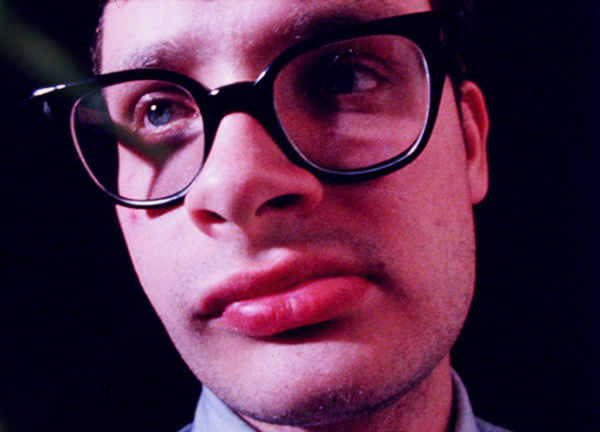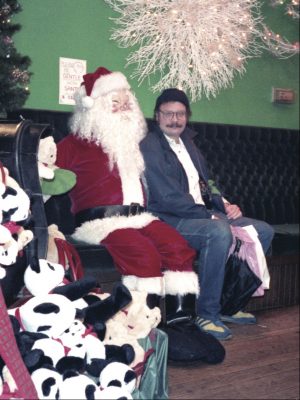George
Kuchar put himself into everything he did. Okay, that’s a cliché. But you can’t
talk about George Kuchar without talking about clichés. George took film
clichés and story-telling conventions and exploded them with a sensual, rakish,
devastatingly charming touch. Whether cinematic or soap-operatic, low-brow or
high-brow, George took the chintzy, schmaltzy effluvia of pop culture, shook it
up, and then reconstituted it in the ambitious, emotionally lurid yet lucid pictures
that he made with his friends. And he helped us recognize the power and pathos
of those conventions by making them seem startlingly new and funny as fuck.
George was able to take something simple and cheap and make you see how
gorgeous and heartbreaking it could be. Life is made of such cheap stuff.
George
was a real fan of Hollywood cinema, from the lush and lavish to the sublime and
ridiculous. George and his twin brother Mike made cinematic spectacles of
themselves with their friends starting in the late 1950s. They were there for
the birth of the New York underground cinema, not as originators, but as
tempest-tossed captains buoyed by the rising new wave of the weird and wild and
unconventional. But unlike some who have tried to follow in his footsteps,
George was never arch or disingenuous. He never laughed at the strange and
wondrous characters in his pictures. They were his friends. And he was right
there in the picture with them.
George
was attracted to people. And people were attracted to George. You can go
through the decades of class films that he made with his students in Studio 8
at the San Francisco Art Institute and see how hungry his students were to be
seen, to look, and to be a part of something fantastical and daring. George was
able to tailor ever-evolving screenplays to get the best out of them. As his
teaching assistant in 1996, I was always amazed by how quickly and easily he
could whip up funny, inventive dialogue. After setting the students in motion
to create the set for the day’s shoot, George would sequester himself briefly
in the small screening room at the back of the classroom and, on a scrap of
paper, would work out the day’s dialogue.
Every
picture that George made came alive with raw emotion. George Kuchar didn’t make
“camp” films or “avant-garde” films or “pornographic” films. George Kuchar made
pictures. Whether on 8mm or 16mm film, or on 8mm or Hi8 or digital video,
George made pictures that embodied his sense of humor and conveyed his
affection for people and his lust for life. He used the word “pictures” to
describe his work not only because he wanted to sidestep the argument about the
seriousness of “cinema” and “films” and the tawdriness of populist “movies”,
but also because he was a skilled illustrator and painter. He imbued his
drawings and paintings with the same mix of rough, unvarnished beauty that he
brought to everything he made. To think of George Kuchar as the apotheosis of
“camp” filmmaking is to miss most of the story. In his vision, melodrama was no
less capable of eliciting true emotion than high drama, tchotchkes were no less
of a lens through which to venerate and contemplate the unknowable than
religious icons.
George
had an incredible eye. If you watch any of the pictures that he and his brother
made together on film, or George’s 8mm and 16mm pictures, you are immediately
struck by his lush compositions, his oversaturated, vibrant colors, his ability
to weave together textures that scream out to be touched and fondled. Indelible
in my mind’s eye are the vibratingly passionate shades of red woven throughout Eclipse of the Sun Virgin (1967). One
scene shows a young man with shellacked black hair standing in a tiled bathroom
wearing a red button-down shirt that resonates with and accentuates the blooming
red spots of his acne. In a series of intercut shots George–with red full
lips–looks, then looks away, then looks again, heightening the fluctuating
tidal pull of attraction and repulsion. The flesh is feeble and imperfect, but
still strong enough to make the spirit weak in the knees as it squirms, chained
and enthralled by the mysterious power of the flesh.
The
compositions and cinematography in the pictures George shot on video were no
less compelling than his work on film. His video work, however, is often
layered with video effects that feel less organic than the animated special
effects that he created for some of his film-based pictures. It isn’t every
artist who can be so accomplished in one medium and then drop it for a cheaper,
new alternative. But when George took up the video camera he discovered new
powers within its constraints. George loved the act of making pictures, the
writing, the special effects, the editing, so much so that he always gravitated
towards the cheapest options so that he could keep constantly working. George
was an enthusiastic proponent of consumer-grade video equipment in an art world
where avant-garde filmmakers fetishized and venerated filmmaking on film as the one and only true path.
George was able to use video cameras in new and inventive ways. The camcorder
technology of the mid-1980s helped George achieve a new level of spontaneity by
allowing him to intercut footage and audio in-camera while shooting on
location. The size and weight of consumer video cameras also allowed him to get
right in amongst the action and to eliminate the distance between himself and
the people in his pictures.
George
was fully himself at all times, and in all situations. In personal conversation
he was very much like how he was in his pictures. He was honest, open, and
incredibly funny. He was unafraid to talk about his love of food, or his bodily
functions, or about his neuroses, but always in the most hilarious, forthright
manner. George loved people, and he wanted everyone to make pictures, to make
art. But when he came into contact with an art world full of big egos he could
be wickedly sarcastic, and incredibly insightful about people's peccadillos and
foibles. George would often punctuate a really rollicking tirade with an
exclamation in his Bronx brogue “Ah, the hell
with it!” He could crack you up just by talking about the weather. But for him
the weather wasn’t just idle, impersonal talk. The weather was Nature’s
Spectacle, full of grandeur and power and beauty of the highest order. And
although he was afraid of its power, he loved it dearly, as you can sense by
watching his Weather Diaries (1986-89). For George the world was full of magic
and wonder and humor.
One
of the most lyrical shots from Hold Me
While I’m Naked (1966) shows clusters of rooftop television
antennae as they throb and shudder, dancing in the wind. This image perfectly
conveys in a succinct image the collective isolation of a nation so newly
entranced by the power of the televisual dreamworld. The swaying antennae, seen through the square of a bathroom window, also
stand in as actors and audience for the isolated protagonist who reaches over and slowly closes the window like a curtain falling in the theatre. Orchestral
strings waver in a frisson of syrupy sentimentality, but the scene is
nonetheless heartbreaking and poignant.
You can learn more about George Kuchar from the resources below:
George Kuchar: The Comedy of the Underground Directed by Gustavo Vazquez O. and David Hallinger
Kuchar Brothers website.
The George Kuchar Reader from 2014.



